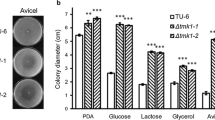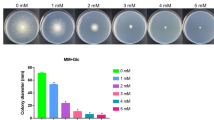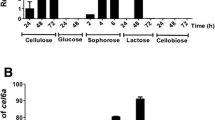Abstract
Purpose
This study aimed to reveal the roles of the protein kinase A catalytic subunit 1 (pkac1) and carbon catabolite repressor cre1 genes in cellulase production by Trichoderma reesei wild-type strain QM6a. Our strategy might be useful to construct a high-yielding cellulase strain for its wide application.
Methods
This paper describes cellulase activity, plate conidiation, and yellow pigment synthesis assays of QM6a with the disruption of pkac1 and cre1.
Results
Deletion of pkac1 (Δpkac1) had no effect on cellulase production or transcript levels of major cellulase genes in the presence of cellulose. Disruption of cre1 (Δcre1) resulted in a remarkable increase in cellulase production and expression of the four major cellulase genes. Double disruption of pkac1 and cre1 significantly improved enzyme activity and protein production. The double disruption also resulted in a significant reduction in yellow pigment production and abrogated conidial production.
Conclusion
Double deletion of pkac1 and cre1 led to increased hydrolytic enzyme production in T. reesei using cellulose as a carbon source.





Similar content being viewed by others
Abbreviations
- CCR:
-
Representing carbon catabolite repressor
- CMCase:
-
Representing endo-β-glucanase activity
- FPase:
-
Filter paper hydrolase, representing total extracellular cellulase activity
- PKA:
-
Representing protein kinase A
- pNPCase:
-
Representing exo-β-glucanase activity
- RT-qPCR:
-
Representing real-time quantitative PCR
References
Antoniêto ACC, de Paula RG, Castro LDS, Silva-Rocha R, Persinoti GF, Silva RN (2016) Trichoderma reesei CRE1-mediated carbon catabolite repression in response to sophorose through RNA sequencing analysis. Curr Genom 17(2):119–131. https://doi.org/10.2174/1389202917666151116212901
Banno S, Ochiai N, Noguchi R, Kimura M, Yamaguchi I, Kanzaki S, Murayama T, Fujimura M (2005) A catalytic subunit of cyclic AMP-dependent protein kinase, PKAC-1, regulates asexual differentiation in Neurospora crassa. Genes Genet Syst 80(1):25–34. https://doi.org/10.1266/ggs.80.25
Benocci T, Aguilar-Pontes MV, Zhou MM, Seiboth B, de Vries RP (2017) Regulators of plant biomass degradation in ascomycetous fungi. Biotechnol Biofuels 10:152. https://doi.org/10.1186/s13068-017-0841-x
Bischof RH, Ramoni J, Seiboth B (2016) Cellulases and beyond: the first 70 years of the enzyme producer Trichoderma reesei. Microb Cell Fact 15(1):106. https://doi.org/10.1186/s12934-016-0507-6
Cai WC, Chen YM, Zhang L, Fang X, Wang W (2022) A three-gene cluster in Trichoderma reesei reveals a potential role of dmm2 in DNA repair and cellulase production. Biotechnol Biofuels Bioprod 15(1):34. https://doi.org/10.1186/s13068-022-02132-y
Castro LDS, Antoniêto ACC, Pedersoli WR, Silva-Rocha R, Persinoti GF, Silva RN (2014) Expression pattern of cellulolytic and xylanolytic genes regulated by transcriptional factors XYR1 and CRE1 are affected by carbon source in Trichoderma reesei. Gene Expr Patterns 14(2):88–95. https://doi.org/10.1016/j.gep.2014.01.003
Chen YM, Shen YL, Wang W, Wei DZ (2018) Mn2+ modulates the expression of cellulase genes in Trichoderma reesei Rut-C30 via calcium signaling. Biotechnol Biofuels 11:54. https://doi.org/10.1186/s13068-018-1055-6
Chen YM, Lin AB, Liu P, Fan XJ, Wu C, Li N, Wei LJ, Wang W, Wei DZ (2021a) Trichoderma reesei ACE4, a novel transcriptional activator involved in the regulation of cellulase genes during growth on cellulose. Appl Environ Microbiol 87(15):e0059321. https://doi.org/10.1128/AEM.00593-21
Chen YM, Fan XJ, Zhao XQ, Shen YL, Xu XY, Wei LJ, Wang W, Wei DZ (2021b) cAMP activates calcium signalling via phospholipase C to regulate cellulase production in the filamentous fungus Trichoderma reesei. Biotechnol Biofuels 14(1):62. https://doi.org/10.1186/s13068-021-01914-0
de Assis LJ, Ries LNA, Savoldi M, Dos Reis TF, Brown NA, Goldman GH (2015) Aspergillus nidulans protein kinase A plays an important role in cellulase production. Biotechnol Biofuels 8:213. https://doi.org/10.1186/s13068-015-0401-1
de Assis LJ, Silva LP, Bayram O, Dowling P et al (2021) Carbon catabolite repression in filamentous fungi is regulated by phosphorylation of the transcription factor CreA. mBio 12(1):e03146. https://doi.org/10.1128/mBio.03146-20
de Paula RG, Antoniêto ACC, Ribeiro LFC, Srivastava N, O’Donovan A, Mishra PK, Gupta VK, Silva RN (2019) Engineered microbial host selection for value-added bioproducts from lignocellulose. Biotechnol Adv 37(6):107347. https://doi.org/10.1016/j.biotechadv.2019.02.003
Fasoyin OE, Wang B, Qiu MG, Han XY, Chung KR, Wang SH (2018) Carbon catabolite repression gene creA regulates morphology, aflatoxin biosynthesis and virulence in Aspergillus flavus. Fungal Genet Biol 115:41–51. https://doi.org/10.1016/j.fgb.2018.04.008
Gong C, Huang JQ, Sun DY, Xu DY, Guo YQ, Kang JG, Niu G, Wang CF (2021) FgSfl1 and its conserved PKA phosphorylation sites are important for conidiation, sexual reproduction, and pathogenesis in Fusarium graminearum. J Fungi 7(9):755. https://doi.org/10.3390/jof7090755
Han ZF, Hunter DM, Sibbald S, Zhang JS, Tian LN (2013) Biological activity of the tzs gene of nopaline Agrobacterium tumefaciens GV3101 in plant regeneration and genetic transformation. Mol Plant Microbe Interact 26(11):1359–1365. https://doi.org/10.1094/MPMI-04-13-0106-R
Han LJ, Liu KM, Ma W, Jiang Y, Hou SL, Tan YS, Yuan QQ, Niu KL, Fang X (2020) Redesigning transcription factor Cre1 for alleviating carbon catabolite repression in Trichoderma reesei. Synth Syst Biotechnol 5(3):230–235. https://doi.org/10.1016/j.synbio.2020.07.002
Hinterdobler W, Schuster A, Tisch D, Özkan E, Bazafkan H, Schinnerl J, Brecker L, Böhmdorfer S, Schmoll M (2019) The role of PKAc1 in gene regulation and trichodimerol production in Trichoderma reesei. Fungal Biol Biotechnol 6:12. https://doi.org/10.1186/s40694-019-0075-8
Hong YH, Cai RL, Guo JY, Zhong ZH, Bao JD, Wang ZH, Chen XF, Zhou J, Lu GD (2021) Carbon catabolite repressor MoCreA is required for the asexual development and pathogenicity of the rice blast fungus. Fungal Genet Biol 146:103496. https://doi.org/10.1016/j.fgb.2020.103496
Ichinose S, Tanaka M, Shintani T, Gomi K (2018) Increased production of biomass-degrading enzymes by double deletion of creA and creB genes involved in carbon catabolite repression in Aspergillus oryzae. J Biosci Bioeng 125(2):141–147. https://doi.org/10.1016/j.jbiosc.2017.08.019
Li CC, Lin FM, Sun W, Yuan SX, Zhou ZH, Wu FG, Chen Z (2018) Constitutive hyperproduction of sorbicillinoids in Trichoderma reesei ZC121. Biotechnol Biofuels 11:291. https://doi.org/10.1186/s13068-018-1296-4
Liu KM, Dong YM, Wang FZ, Jiang BJ, Wang MY, Fang X (2016) Regulation of cellulase expression, sporulation, and morphogenesis by velvet family proteins in Trichoderma reesei. Appl Microbiol Biotechnol 100(2):769–779. https://doi.org/10.1007/s00253-015-7059-2
Lv DD, Wang W, Wei DZ (2012) Construction of two vectors for gene expression in Trichoderma reesei. Plasmid 67(1):67–71. https://doi.org/10.1016/j.plasmid.2011.10.002
Mello-de-Sousa TM, Gorsche R, Rassinger A, Poças-Fonseca MJ, Mach RL, Mach-Aigner AR (2014) A truncated form of the carbon catabolite repressor 1 increases cellulase production in Trichoderma reesei. Biotechnol Biofuels 7(1):129. https://doi.org/10.1186/s13068-014-0129-3
Meng QS, Zhang F, Liu CG, Zhao XQ, Bai FW (2020) Identification of a novel repressor encoded by the putative gene ctf1 for cellulase biosynthesis in Trichoderma reesei through artificial zinc finger engineering. Biotechnol Bioeng 117(6):1747–1760. https://doi.org/10.1002/bit.27321
Nakari-Setälä T, Paloheimo M, Kallio J, Vehmaanperä J, Penttilä M, Saloheimo M (2009) Genetic modification of carbon catabolite repression in Trichoderma reesei for improved protein production. Appl Environ Microbiol 75(14):4853–4860. https://doi.org/10.1128/AEM.00282-09
Rassinger A, Gacek-Matthews A, Strauss J, Mach RL, Mach-Aigner AR (2018) Truncation of the transcriptional repressor protein Cre1 in Trichoderma reesei Rut-C30 turns it into an activator. Fungal Biol Biotechnol 5:15. https://doi.org/10.1186/s40694-018-0059-0
Ribeiro LFC, Chelius C, Boppidi KR, Naik NS et al (2019) Comprehensive analysis of Aspergillus nidulans PKA phosphorylome identifies a novel mode of CreA regulation. mBio 10(2):e02825–e02918. https://doi.org/10.1128/mBio.02825-18
Rytioja J, Hildén K, Yuzon J, Hatakka A, de Vries RP, Mäkelä MR (2014) Plant-polysaccharide-degrading enzymes from basidiomycetes. Microbiol Mol Biol Rev 78(4):614–649. https://doi.org/10.1128/MMBR.00035-14
Schmoll M (2008) The information highways of a biotechnological workhorse—signal transduction in Hypocrea jecorina. BMC Genom 9:430. https://doi.org/10.1186/1471-2164-9-430
Schuster A, Tisch D, Seidl-Seiboth V, Kubicek CP, Schmoll M (2012) Roles of protein kinase A and adenylate cyclase in light-modulated cellulase regulation in Trichoderma reesei. Appl Environ Microbiol 78(7):2168–2178. https://doi.org/10.1128/AEM.06959-11
Steiger MG, Mach RL, Mach-Aigner AR (2010) An accurate normalization strategy for RT-qPCR in Hypocrea jecorina (Trichoderma reesei). J Biotechnol 145(1):30–37. https://doi.org/10.1016/j.jbiotec.2009.10.012
Tokin R, Ipsen JØ, Westh P, Johansen KS (2020) The synergy between LPMOs and cellulases in enzymatic saccharification of cellulose is both enzyme- and substrate-dependent. Biotechnol Lett 42(10):1975–1984. https://doi.org/10.1007/s10529-020-02922-0
Tsai HC, Yang SL, Chung KR (2013) Cyclic AMP-dependent protein kinase A negatively regulates conidia formation by the tangerine pathotype of Alternaria alternata. World J Microbiol Biotechnol 29(2):289–300. https://doi.org/10.1007/s11274-012-1182-3
Wu C, Chen YM, Qiu YF, Niu X, Zhu NJ, Chen JH, Yao H, Wang W, Ma YS (2020) A simple approach to mediate genome editing in the filamentous fungus Trichoderma reesei by CRISPR/Cas9-coupled in vivo gRNA transcription. Biotechnol Lett 42(7):1203–1210. https://doi.org/10.1007/s10529-020-02887-0
Zhang L, Zhao XH, Zhang GX, Zhang JJ, Wang XD, Zhang SP, Wang W, Wei DZ (2016) Light-inducible genetic engineering and control of non-homologous end-joining in industrial eukaryotic microorganisms: LML 3.0 and OFN 1.0. Sci Rep 6:20761. https://doi.org/10.1038/srep20761
Zhang JJ, Wu C, Wang W, Wang W, Wei DZ (2018a) A versatile Trichoderma reesei expression system for the production of heterologous proteins. Biotechnol Lett 40(6):965–972. https://doi.org/10.1007/s10529-018-2548-x
Zhang JJ, Zhang GX, Wang W, Wang W, Wei DZ (2018b) Enhanced cellulase production in Trichoderma reesei RUT C30 via constitution of minimal transcriptional activators. Microb Cell Fact 17(1):75. https://doi.org/10.1186/s12934-018-0926-7
Funding
This work was supported by the Natural Science Foundation of Shanghai, China (No. 22ZR1417600), the National Natural Science Foundation of China (32000050), and Shanghai Agriculture Applied Technology Development Program, China (Grant No. 2021-02-08-00-12-F00758).
Author information
Authors and Affiliations
Contributions
WW conceived and directed the study and reviewed the manuscript. NL carried out experiments and measurements, analyzed the data and wrote the manuscript. YC interpreted experimental data and supported the research funding. YS reviewed the manuscript. All authors have read and approved the final manuscript.
Corresponding author
Ethics declarations
Conflict of interest
All authors declare that they have no conflict of interest.
Ethical approval
This article does not contain any studies with human participants or animals performed by the authors.
Additional information
Publisher's Note
Springer Nature remains neutral with regard to jurisdictional claims in published maps and institutional affiliations.
Rights and permissions
Springer Nature or its licensor (e.g. a society or other partner) holds exclusive rights to this article under a publishing agreement with the author(s) or other rightsholder(s); author self-archiving of the accepted manuscript version of this article is solely governed by the terms of such publishing agreement and applicable law.
About this article
Cite this article
Li, N., Chen, Y., Shen, Y. et al. Roles of PKAc1 and CRE1 in cellulose degradation, conidiation, and yellow pigment synthesis in Trichoderma reesei QM6a. Biotechnol Lett 44, 1465–1475 (2022). https://doi.org/10.1007/s10529-022-03312-4
Received:
Accepted:
Published:
Issue Date:
DOI: https://doi.org/10.1007/s10529-022-03312-4




